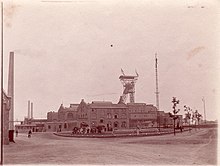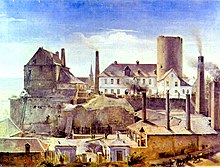industrialization


Industrialization is a process within a state , during which an agricultural state develops into an industrial state. The opposite is de-industrialization .
General
At first there were only agricultural states worldwide. With these it must be taken into account that the production of agricultural products can be subject to strong weather-related fluctuations ( crop failures due to drought , pests or floods ). The state objective of the agricultural state is above all subsistence farming for self-sufficiency with self- produced agricultural products, ideally with a degree of self-sufficiency of 100%. Industrialization describes technical - economic processes of transition from agricultural to industrial modes of production , in which the mechanical production of goods and services asserts itself .
The distinction between industrialized and agricultural countries is based on the prevailing economic sector ( industrial production or agricultural production ) and their share in the gross domestic product (GDP) or the share of those in employment in those sectors in relation to the total workforce. Typical agricultural states are all developing and most of the emerging countries . They have the greatest market potential for their industrialization.
Economic causes
In his three-sector hypothesis in 1949, Jean Fourastié assumed a state model that comprised three sectors, namely the primary sector ( agriculture , fishing and forestry ; in the broader sense also mining ), the secondary sector ( construction , energy and water supply , crafts or manufacturing ) and the tertiary sector ( services in finance , research and development , catering , trade , real estate industry , transport and communications , public administration , etc.).
With his three-sector or three-phase model, Fourastié tried to explain the ideal-typical development of an economy up to a service society ( sectoral structural change ). Starting from the agricultural market, industrial production is growing, increasingly producing agricultural technology and subject to technical progress , so that jobs in the primary sector disappear and are needed in the secondary sector. A market saturation occurs the fastest one for products of the primary sector, then where the secondary sector, while the demand by which the tertiary sector is unlimited and stay. The increasing automation and mechanization in these sectors lead to more free time for the workers, which strengthens the services of the tertiary sector.
history
In the Middle Ages around 70% of employees worldwide worked in the primary, 20% in the secondary and only 10% in the tertiary sector - the typical structure of an agricultural state. England is the first industrial nation in the world, and the country owed its rise to coal and iron. From 1765 a change occurred there, which was heralded by falling grain exports, which were also due to the growth of industry and trade. Pacemaker technologies were the invention of the steam engine (1712 by Thomas Newcomen , decisive further development in 1769 by James Watt ), the spinning machine ( Spinning Jenny ), the mechanical loom , the machine tool and the puddling process in iron extraction . The invention of the steam locomotive and the first public railways marked the end of the (first) industrial revolution in England. It laid the groundwork for a bourgeois industrial state, which Arnold Toynbee described in 1882 as the industrial revolution ( English industrial revolution ). For Fourastié, the transition period began here when around 50% were employed in the secondary sector at the expense of the primary sector (with only 20%), while the tertiary sector now had 30%.
After the end of the Congress of Vienna in June 1815, the industrial revolution began in Germany with early industrialization . The main reasons included the establishment of the “Preußisch-Rheinische Dampfschifffahrtsgesellschaft” (forerunner of the Cologne-Düsseldorf German Rhine Shipping Company ) in October 1825, followed by the Rheinische Eisenbahn-Gesellschaft in June 1837 and the Cologne-Mindener Eisenbahn-Gesellschaft in October 1843 . Ship and railroad construction benefited from this . At the forefront of railway construction was the Borsig company , which produced its first locomotive in 1841 and its thousandth in 1858 and with 1,100 employees rose to become the third-largest locomotive factory in the world ( high industrialization in Germany ).
The industrialization of France picked up speed between 1830 and 1860, there was a rapid increase in industrial production. The industrial revolution began comparatively late in the USA , swiftly since 1850 and clearly recognizable from 1865 after the Civil War .
Fourastié's hypothesis of the “tertiary civilization” from 1949 saw 80% of the employees in the tertiary sector in the future, industry and the agricultural sector would each fall to 10%. An industrial criticism was expressed early on during industrialization , which later turned into an ecological criticism .
statistics
The following statistics are broken down into the three classic sectors, measured by the share of each sector in GDP.
Africa
In the typical agricultural states of Africa , the tertiary sector is always larger than the secondary sector, as the following selection shows:
| country | Agriculture in% of GDP *) |
Industry in% of GDP *) |
Services in% of GDP *) |
|---|---|---|---|
|
|
39.5 | 16.4 | 44.2 |
|
|
50.0 | 13.1 | 36.9 |
|
|
47.7 | 11.8 | 40.5 |
|
|
41.8 | 18.1 | 40.5 |
|
|
41.6 | 19.5 | 38.7 |
|
|
60.7 | 6.5 | 32.8 |
|
|
60.2 | 7.4 | 32.5 |
|
|
39.6 | 2.6 | 57.8 |
|
|
52.3 | 14.7 | 33.1 |
|
|
43.2 | 16.0 | 40.8 |
- (*) Note: There are rounding differences.
In the first ten places of global agricultural states there are only states from Africa. African countries also dominate the other places, with Tajikistan first following in 20th place with 28.6% as the first non-African country. Sierra Leone (60.7%) has the highest share of agricultural production in GDP , followed by Somalia (60.2%), Chad (52.3%) and Guinea-Bissau (50.0%). In all three countries the service sector is stronger than industry. Sudan and Burundi have already transformed into a service society.
South America
In South America , industrialization is largely complete:
| country | Agriculture in% of GDP *) |
Industry in% of GDP *) |
Services in% of GDP *) |
|---|---|---|---|
|
|
10.8 | 28.1 | 61.1 |
|
|
6.6 | 20.7 | 72.7 |
|
|
4.2 | 32.8 | 63.0 |
|
|
7.2 | 32.8 | 60.1 |
|
|
3.6 | 31.9 | 64.5 |
|
|
7.6 | 32.7 | 59.9 |
|
|
6.2 | 24.1 | 69.7 |
|
|
4.7 | 40.4 | 54.9 |
- (*) Note: There are rounding differences
The service sector dominates in all shown states of South America and is more important than industry. Agriculture is almost meaningless.
Asia
Asia shows a very differentiated picture:
| country | Agriculture in% of GDP *) |
Industry in% of GDP *) |
Services in% of GDP *) |
|---|---|---|---|
|
|
7.9 | 40.5 | 51.6 |
| Hong Kong | 0.1 | 7.6 | 92.3 |
|
|
15.4 | 23.0 | 61.5 |
|
|
13.7 | 41.0 | 45.4 |
|
|
22.5 | 47.6 | 29.9 |
|
|
2.2 | 39.3 | 58.3 |
|
|
8.8 | 37.6 | 53.3 |
|
|
9.6 | 30.6 | 59.8 |
|
|
0.0 | 24.8 | 75.2 |
|
|
15.3 | 33.3 | 51.3 |
- (*) Note: There are rounding differences
In all countries except North Korea , the service sector is the largest sector.
economic aspects
The per capita income is higher in industrialized countries than in purely agricultural countries because the price level of industrial products is higher and the value chain is more extensive than for agricultural products. The per capita income of the agricultural state of Burundi was almost US $ 700 in 2017, compared to US $ 44,300 in Great Britain. In order to improve the income of the population, industrialization in agricultural states is attractive. The industrialization phase is characterized by industrial structural change , in which jobs in agriculture are lost and vacancies in industry are created. This process leads to sectoral unemployment ( underemployment ) in agriculture and overemployment in industry until the adjustment processes are completed.
consequences
As industrialization following effects can be the urbanization , the shift from self - ( subsistence ) for foreign utility company, declining birth rates , prosperity (in the developed world ), but also the increasing democratization, which was dependent on the growing wealth was followed by an increasing environmental pollution and in particular the global warming .
See also
literature
- Flurin Condrau : The industrialization in Germany . Scientific Book Society, Darmstadt 2005, ISBN 978-3-534-15008-3 .
- Clark Kerr, John T. Dunlop, Frederick Harbison, Charles A. Myers: The man in the industrial society (Original title: Industrialism and Industrial Man ). European Publishing House, Frankfurt am Main 1960.
- Klaus Tenfelde: Industrialization . In: Richard van Dülmen (Hrsg.): The Fischer Lexicon History . Fischer, Frankfurt am Main 2003, pp. 222-237, ISBN 978-3-596-15760-0 .
- Richard H. Tilly : Industrialization as a Historical Process . In: European History Online , ed. from the Institute for European History (Mainz) , 2010, urn : nbn: de: 0159-20101025166 .
- Wolfgang Wüst (Hrsg.): Regional economic and industrial history in small-town-rural surroundings (micro and macro - comparative regional studies 1) Erlangen 2015, ISBN 978-3-940804-07-5 .
Web links
- Béatrice Veyrassat: industrialization. In: Historical Lexicon of Switzerland .
Individual evidence
- ^ Karl-Heinz Hillmann : Dictionary of Sociology (= Kröner's pocket edition , Volume 410). 4th revised and expanded edition. Kröner, Stuttgart 1994, ISBN 3-520-41004-4 , p. 260
- ^ Flurin Condrau : The industrialization in Germany . Scientific Book Society, Darmstadt 2005, p. 5
- ↑ Ute Arentzen, Eggert Winter (ed.): Gabler Wirtschafts-Lexikon . Volume 3, 1997, Col. 1855
- ^ Jean Fourastié: Le Grand Espoir du XXe siècle. Progrès technique, progrès économique, progrès social . 1949, p. 64 ff.
- ^ Jean Fourastié: Le Grand Espoir du XXe siècle. Progrès technique, progrès économique, progrès social , 1949, p. 86 ff.
- ^ Beat Hotz-Hart, Patrick Dümmler, Daniel Schmuki: Economics of Switzerland: Departure into the 21st century . 2006, p. 381
- ↑ Hubert Kiesewetter : The unique Europe . 1996, p. 173
- ↑ Felix Salomon: William Pitt the Younger . Volume 1. 1906, p. 396 f.
- ↑ Hans-Dieter Gelfert: Small history of the English literature . 2005, p. 151
- ↑ Gabriele Oepen-Domschky: Cologne economic citizen of the German Empire . 2003, p. 150
- ↑ Peter Lösche (Ed.): Country Report USA , 2004, p. 81 f.
- ^ Jean Fourastié: Le Grand Espoir du XXe siècle. Progrès technique, progrès économique, progrès social . 1949, p. 126
- ↑ Gross domestic product (GDP) by sector. In: Lexa's country data. November 28, 2018, accessed October 10, 2019 . Quoted there from Field Listing - GDP, composition, by sector of origin. In: The World Factbook . CIA , accessed October 10, 2019 .
- ↑ gross domestic product (GDP) per capita. In: Lexa's country data. November 28, 2018, accessed October 10, 2019 . Quoted there from Field Listing :: GDP - composition, by sector of origin. In: The World Factbook . CIA , accessed October 10, 2019 .
- ↑ On the connection between democratization and industrialization: Hedwig Richter: Moderne Wahlen. A history of democracy in Prussia and the USA in the 19th century . Hamburger Edition, 2017, pp. 94–111



